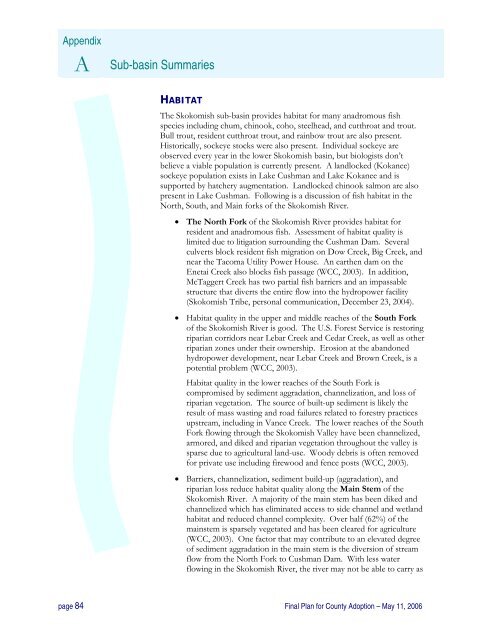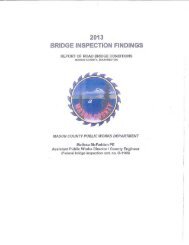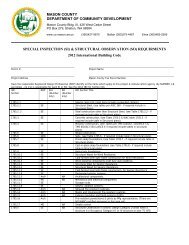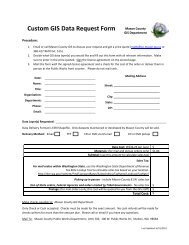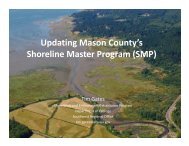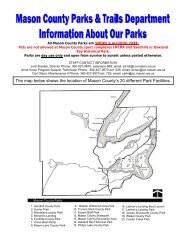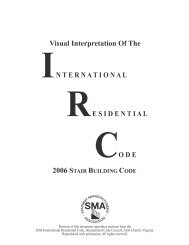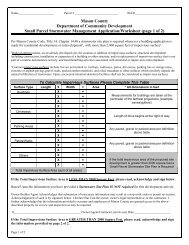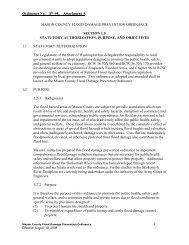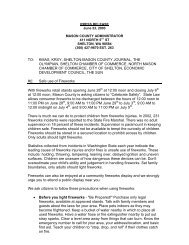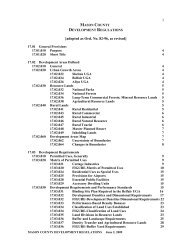Watershed Management Plan - Mason County
Watershed Management Plan - Mason County
Watershed Management Plan - Mason County
Create successful ePaper yourself
Turn your PDF publications into a flip-book with our unique Google optimized e-Paper software.
Appendix<br />
A Sub-basin Summaries<br />
HABITAT<br />
The Skokomish sub-basin provides habitat for many anadromous fish<br />
species including chum, chinook, coho, steelhead, and cutthroat and trout.<br />
Bull trout, resident cutthroat trout, and rainbow trout are also present.<br />
Historically, sockeye stocks were also present. Individual sockeye are<br />
observed every year in the lower Skokomish basin, but biologists don’t<br />
believe a viable population is currently present. A landlocked (Kokanee)<br />
sockeye population exists in Lake Cushman and Lake Kokanee and is<br />
supported by hatchery augmentation. Landlocked chinook salmon are also<br />
present in Lake Cushman. Following is a discussion of fish habitat in the<br />
North, South, and Main forks of the Skokomish River.<br />
• The North Fork of the Skokomish River provides habitat for<br />
resident and anadromous fish. Assessment of habitat quality is<br />
limited due to litigation surrounding the Cushman Dam. Several<br />
culverts block resident fish migration on Dow Creek, Big Creek, and<br />
near the Tacoma Utility Power House. An earthen dam on the<br />
Enetai Creek also blocks fish passage (WCC, 2003). In addition,<br />
McTaggert Creek has two partial fish barriers and an impassable<br />
structure that diverts the entire flow into the hydropower facility<br />
(Skokomish Tribe, personal communication, December 23, 2004).<br />
• Habitat quality in the upper and middle reaches of the South Fork<br />
of the Skokomish River is good. The U.S. Forest Service is restoring<br />
riparian corridors near Lebar Creek and Cedar Creek, as well as other<br />
riparian zones under their ownership. Erosion at the abandoned<br />
hydropower development, near Lebar Creek and Brown Creek, is a<br />
potential problem (WCC, 2003).<br />
Habitat quality in the lower reaches of the South Fork is<br />
compromised by sediment aggradation, channelization, and loss of<br />
riparian vegetation. The source of built-up sediment is likely the<br />
result of mass wasting and road failures related to forestry practices<br />
upstream, including in Vance Creek. The lower reaches of the South<br />
Fork flowing through the Skokomish Valley have been channelized,<br />
armored, and diked and riparian vegetation throughout the valley is<br />
sparse due to agricultural land-use. Woody debris is often removed<br />
for private use including firewood and fence posts (WCC, 2003).<br />
• Barriers, channelization, sediment build-up (aggradation), and<br />
riparian loss reduce habitat quality along the Main Stem of the<br />
Skokomish River. A majority of the main stem has been diked and<br />
channelized which has eliminated access to side channel and wetland<br />
habitat and reduced channel complexity. Over half (62%) of the<br />
mainstem is sparsely vegetated and has been cleared for agriculture<br />
(WCC, 2003). One factor that may contribute to an elevated degree<br />
of sediment aggradation in the main stem is the diversion of stream<br />
flow from the North Fork to Cushman Dam. With less water<br />
flowing in the Skokomish River, the river may not be able to carry as<br />
page 84 Final <strong>Plan</strong> for <strong>County</strong> Adoption – May 11, 2006


